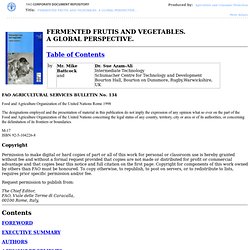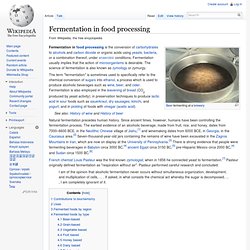

Fermented frutis and vegetables. A global perspective. Table of contents. Table of Contents FAO AGRICULTURAL SERVICES BULLETIN No. 134 Food and Agriculture Organization of the United Nations Rome 1998 The designations employed and the presentation of material in this publication do not imply the expression of any opinion what so ever on the part of the Food and Agriculture Organization of the United Nations concerning the legal status of any country, territory, city or area or of its authorities, or concerning the delimitation of its frontiers or boundaries.

Copyright Permission to make digital or hard copies of part or all of this work for personal or classroom use is hereby granted without fee and without a formal request provided that copies are not made or distributed for profit or commercial advantage and that copies bear this notice and full citation on the first page.
Fermentation (food) Fermentation in food processing is the conversion of carbohydrates to alcohols and carbon dioxide or organic acids using yeasts, bacteria, or a combination thereof, under anaerobic conditions.

Fermentation usually implies that the action of microorganisms is desirable. The science of fermentation is also known as zymology or zymurgy. The term "fermentation" is sometimes used to specifically refer to the chemical conversion of sugars into ethanol, a process which is used to produce alcoholic beverages such as wine, beer, and cider. Category:Fermented foods. Many pickled or soured foods are fermented as part of the pickling or souring process, but many are simply processed with brine, vinegar, or another acid such as lemon juice.

Subcategories This category has the following 10 subcategories, out of 10 total. Pages in category "Fermented foods" The following 127 pages are in this category, out of 127 total.